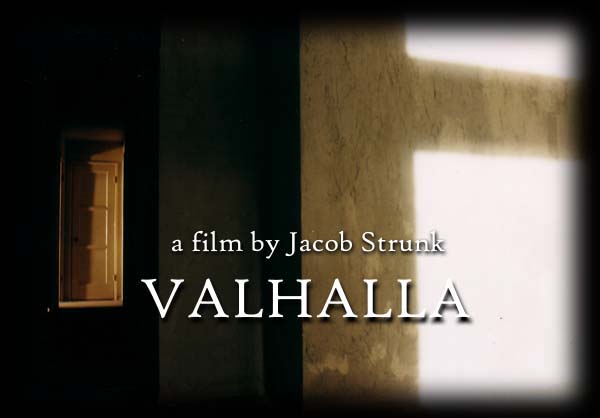 |
 |
|||||||||
 |
||||||||||
 |
 |
 |
 |
 |
 |
 |
 |
|||

Valhalla
came out of the air.
Working
in conjunction with Brooks Institute & Glynn Beard, director Jacob Strunk
had procured a Sony CineAlta camera package for use on his short film Sand
Country. There was a very
limited amount of time the camera would be available.
Two
weeks before production, an image conjured itself in Strunk’s head.
He saw, in vivid detail, what would become the opening shot of Valhalla.
Strunk saw the chance to shoot the film on 24P HD as an opportunity to
tell a story revolving around remarkable detail. He immediately made a phone call and got the camera for two
extra days. Two days…in two
weeks…and there was no script yet.
That
night, Strunk sat down and wrote the first – and ultimately final – draft of Valhalla. It was one
sitting, one evening, and in one frantic session, the film appeared, trailing
behind a blinking cursor on his screen. The
story virtually wrote itself as Sutton (Beard) stumbled through an eerily empty
house.
With
ten days until the shoot, Strunk took the script to Beard for his opinion.
The next step was casting. The
film’s production would be small, with the narrative surrounding but one
character. Finding the right person
for that character would prove harder than he first imagined.
Strunk’s
first two possibilities dropped off the project, citing reasons he could only
chalk up to an embarrassed lack of interest in something so seemingly morbid
and, well, odd. It was here that
Beard stepped in.
The
two had collaborated before. Beard
appeared in a featured role in Go Man Go, a short film produced for the
Pioneer 2880 Project which Strunk wrote and directed.
Strunk had also served as Assistant Director on Beard’s film Success,
the first installment in a series of nine short films.
Strunk knew Beard could act, he had seen it before.
And
with that, Beard was cast in the role. The
match proved to be perfect. With
Glynn Beard acting under Jacob Strunk’s direction, the space proved a fertile
bed for creativity and the two fleshed out the character – and the film – together. Beard beautifully found
the character Strunk had envisioned and each scenario, only weeks prior typed
out in that frenzied writing session, became rich with life.
The
shoot went more smoothly than it should have, and the crew moved admirably
quickly. Beard soon realized
Strunk’s method of bringing the character to the screen as realistically as
possible was shooting as few takes as possible, capturing genuine moments
instead of rehearsed actions.
This method proved more than effective at bringing through the camera and onto the screen the atmosphere, emotion, and raw feel Strunk was looking for. The film in his head found itself footing and came into being. The momentum from the shoot carried him into the editing room, where he cut the film into the final product, a perfect representation of the twisted vision which had come to him two weeks earlier. A screening with Beard, sound man Dale Angell, D.P. Johnny Bishop, advisor David Roy, and Strunk's own mother proved the film succeeded in creating a world of its own.
And
so, a mere two weeks after the idea’s inception, Valhalla came into
being…out of the air.

